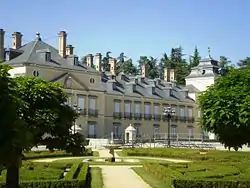Royal Palace of El Pardo
The Royal Palace of El Pardo (Spanish: Palacio Real de El Pardo, pronounced [paˈlaθjo reˈal de el ˈpaɾðo]) is one of the official residences of the Spanish royal family and one of the oldest, being used by the Spanish monarchs since Henry III of Castile in the 15th century. It is administered by the Patrimonio Nacional agency and it currently serves as a state guest house.
| Royal Palace of El Pardo | |
|---|---|
Palacio Real de El Pardo | |
 Main façade | |
| General information | |
| Architectural style | Spanish Renaissance, Neoclassical |
| Location | Madrid, Spain |
| Design and construction | |
| Architect(s) | Luis de Vega Francesco Sabatini |
| Official name | Palacio Real de El Pardo |
| Type | Non-movable |
| Criteria | Monument |
| Designated | 1931 |
| Reference no. | RI-51-0001062 |

Overview
The palace began as a royal hunting lodge. It became an alternative residence of the kings of Spain until the reign of King Alfonso XII of Spain, who died in the palace in 1885.
King Henry III of Castile ordered the building of the pavilion in 1406, on Mount El Pardo, because of its abundant game. In the 1540s, on the orders of Emperor Charles V, it was transformed into a palace by the architect Luis de Vega. On 13 March 1604, a massive fire destroyed many of the paintings the palace housed, including masterpieces by Titian. King Carlos III of Spain renovated the building in the 18th century, appointing his architect Francesco Sabatini to undertake the job.
The interior decoration includes a ceiling frescoed by Gaspar Becerra, and paintings by Vincenzo Carducci and Cabrera.
In 1739 the palace hosted talks between the governments of Great Britain and Spain, who eventually agreed to the Convention of Pardo in a bid to avert a war. However, the Convention failed to prevent the War of Jenkins' Ear from breaking out shortly afterwards.
Dictator Francisco Franco commandeered the palace as his residence after the Spanish Civil War and lived there until his death.
Access
Since Franco's death, the building has been used as a residence for visiting heads of state. When not in use by guests, it is open to the public. Objects on display include tapestries made by the Royal Tapestry Factory. Goya was one of the artists who designed tapestries for the palace with dimensions corresponding to specific locations in the building.[1]
See also
- Casita del Principe (El Pardo), a related building for recreational use
- Palace of Zarzuela, nearby royal residence
- Ward of El Pardo
References
- "The flower girls (Las floreras)". Retrieved 2019-11-18.
External links
![]() Media related to Royal Palace of El Pardo at Wikimedia Commons
Media related to Royal Palace of El Pardo at Wikimedia Commons
